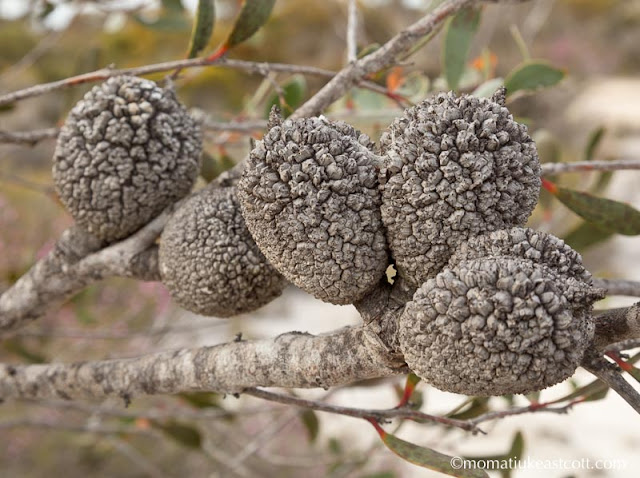 John and I wake, once again this antipodean spring, in a scraggly grove of young gum trees. The small trees are patiently peeling their bark skins and scattering them over the sandy soil. There is also a multitude of sticks, just your ordinary twigs which lost their moorings. And many fire-darkened tree stumplets, small and hard to see in the brush. The sky is flat and hard to see through the glare, and the air smells of eucalyptus perfume. There may also be some spring flowers, the joker card of tourist brochures which herald their profuse seasonal blossomness in Western Australia but they are so well hidden in all this brushy stickiness it takes an overwhelming faith in remote possibilities to drag our cameras out.
John and I wake, once again this antipodean spring, in a scraggly grove of young gum trees. The small trees are patiently peeling their bark skins and scattering them over the sandy soil. There is also a multitude of sticks, just your ordinary twigs which lost their moorings. And many fire-darkened tree stumplets, small and hard to see in the brush. The sky is flat and hard to see through the glare, and the air smells of eucalyptus perfume. There may also be some spring flowers, the joker card of tourist brochures which herald their profuse seasonal blossomness in Western Australia but they are so well hidden in all this brushy stickiness it takes an overwhelming faith in remote possibilities to drag our cameras out.When it comes to such abiding faith in spite of all indications to the contrary, John just shines and grows to be eight foot tall. Maybe taller. He extracts his tripod, puts together an intricate combination of a lens, a tilt and only John knows what else, and goes to work in the nearest ditch. And unless there is a pronounced reason to stop, he may continue his quest for a long time. He can, I know, also drop it all if need be, grab any camera and run to capture something happening NOW. But this is what most photographers can do, including myself, and it is his intense focus on possibilities and the stubborn pursuit of them which often takes my breath away.
Once he gets intrigued by his idea of a picture, John can stand riveted to one place for hours. If the flowers are too widely spaced, he may just bring them gently together and persuade them to stay put. If their planes of focus differ too much to render them all sharp, he takes many exposures and combine them. If the light goes all to hell, he waits for it to improve. If he needs to pee, he ignores it.
It is different for me. I need clear impulses, visual upheavals, sudden prompts of emotions and naked jolts of beauty or drama. I need nature to speak to me and not the other way around. Speak, damn you. Yell, if need be. Drag me out and into this dry, sticky and thoroughly nondescript place, and I may switch into my usual photographic mode: driven, careless, and prone to mistakes. I just need a glimmer of hidden surprises and my adrenaline will surge and do its erratic best.
Right now I am ashamed of my passive wait: all I have to do is kick myself into our well practiced "ditch" mode. We are both good at stopping along an un-busy ribbon of a road to explore its ditch riches. A leaf here, a rock there. A clump of ferns over yonder. And once, a lone hitchhiker.
Right now I am ashamed of my passive wait: all I have to do is kick myself into our well practiced "ditch" mode. We are both good at stopping along an un-busy ribbon of a road to explore its ditch riches. A leaf here, a rock there. A clump of ferns over yonder. And once, a lone hitchhiker.
So I go and sniff around; good dog. More broken sticks. More hidden flowers. More bushy plants made of grey dust. Nothing. But wait! What are these corrugated balls, as hard as iron? I touch them and try to figure their biological function.
Giant seed pouches, as in tree testicles? Hidden fruit for jaws made of titanium? To investigate further, I try to twist one of them off, then another, but they seem welded to the branches they grow on, and the branches (I do try to break one, too) are as hard as marble. Iron, titanium, marble? What the hell?
And I suddenly remember an Aboriginal painting at the National Art Gallery in Canberra we saw recently with John's nephew, Dave. Textures, dust and lines. Points. Dry dry dry. Both the painting and these hard orbs emerge straight from nature and share the same unforgiving hardness and its mystery.
Eventually we leave our scraggly sticks and near a coastal lake we spot paper bark tea trees dangling over calm water. Named Melaleuca quinquenerviain Latin, they have thinly layered trunks and pale paper-thin bark peeling like mad, neatly stacked and ironed by time.
Like this, maybe?
I walk and discover a narrow gap between giant boulders and a white sand pocket which will vanish once the tide comes in. The sea will fill this space with its powerful milky presence of many bubbles. Only the rocks will stick out, darkly.
© Yva Momatiuk








